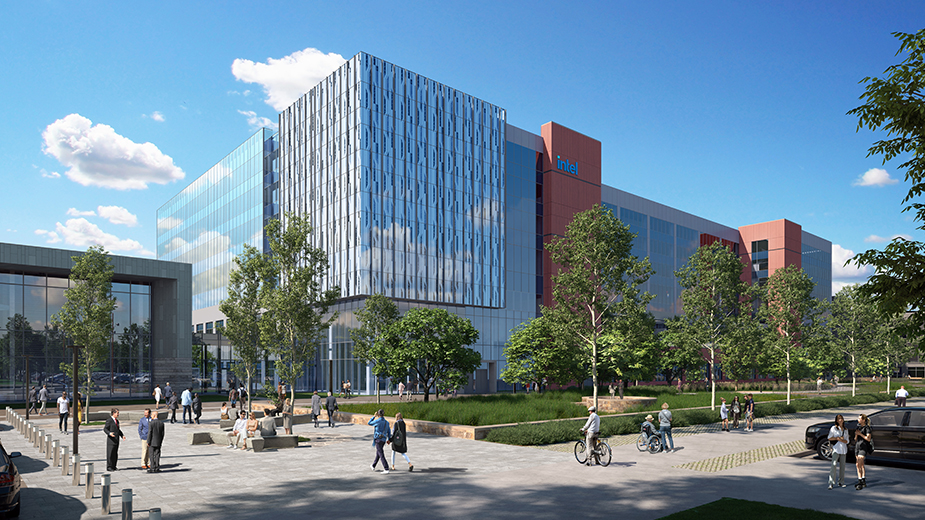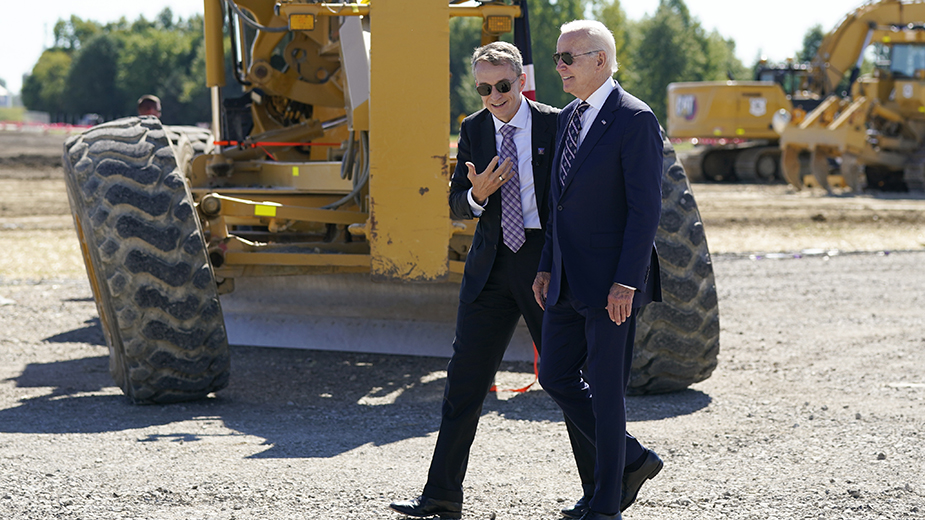YOUNGSTOWN, Ohio – Announcements for major suppliers to Intel’s new plant near Columbus may not be coming anytime soon in the Mahoning Valley. But this region is sure to feel the economic reverberations of such a massive undertaking, development specialists say.
To them, Intel’s decision to build its chip manufacturing plants in Ohio is just the beginning in what the company and public officials have christened as the “Silicon Heartland.”
“The magnitude of this project will have a ripple effect across the state,” says Guy Coviello, president and CEO of the Youngstown/Warren Regional Chamber. “We don’t know how big the ripple will be because we’ve never had a project this big.”
Intel announced in January that it would build two semiconductor-manufacturing plants – better known in industry parlance as “fabs” – in New Albany, Ohio, thereby creating thousands of jobs. The project represents the single largest private investment in the history of Ohio.
Dignitaries including President Joe Biden attended the groundbreaking ceremony Sept. 9 to celebrate the $20 billion project, which Intel CEO Pat Gelsinger described as restoring the United States to “its rightful place as a leader in advanced chipmaking.
“Today marks a pivotal moment in the journey to build a more geographically balanced and resilient semiconductor supply chain,” Gelsinger said. “The establishment of the Silicon Heartland is testament to the power of government incentives to unlock private investment, create thousands of high-paying jobs, and benefit U.S. economic and national security.”
Coviello believes that a project of this size is likely to attract a cluster of companies in the same industry – companies that could be well suited for northeastern Ohio. “It’s not going to end with Intel,” he says.
The key is to harness the aftershocks of the enormous project. The Youngstown/Warren Regional Chamber has formed a semiconductor supply chain task force that comprises fellow chambers in Akron, Canton and Cleveland, Coviello says.
“We’re meeting periodically to figure out how to take advantage of this ripple effect,” he says.
Coviello anticipates that others in the semiconductor industry will follow Intel’s lead and take a hard look at Ohio for their next location. He also projects, however, that these companies are more likely to look outside the Columbus area because competition for talent would be fierce in that market.
“The same thing goes for the supply chains,” he says. “We’ve had about a half dozen meetings and brought in some people with expertise in the industry.”
The semiconductor business stands to change how organizations such as the regional chamber go about selecting sites for potential prospects in the Mahoning Valley, Coviello says.
“It’s led us to change our strategies a little bit,” he says. In the past, the traditional method of marketing the Mahoning Valley touted the region’s proximity and access to the country’s highway and rail system.
“In the chip manufacturing industry, it’s just the opposite,” Coviello says. “They want to know how far away they can get from these highways and rails.”
That’s because the slightest geological vibration or disturbance could ruin the etching process during chip manufacturing, Coviello explains: “It’s forcing us to look at site readiness in a way we haven’t looked at it before.”
Chip manufacturers use clean rooms that are more sanitized than a hospital emergency room, Coviello says, as do many of the companies that supply the semiconductor industry. These suppliers support the biomedical industry as well, which could open an opportunity to lure a new segment of the tech sector to the region.
“We don’t know how big this ripple effect is going to be. [Coviello pauses briefly.] But probably pretty big.”

Construction work at the 926-acre site is expected to last nearly three years. During that period, Intel estimates it will create more than 7,000 jobs for the building trades. Once operating at full capacity, Intel plans to employ some 3,000 people at the site with an average salary of $135,000. Chip production is expected to begin sometime in 2025.
Moreover, the location is large enough to accommodate eight of these fabs. Intel officials have said the company’s investment could reach $100 billion within a decade.
The jobs multiplier effect could be substantial across Ohio. According to Intel’s estimates, about 15,000 additional indirect jobs in the Columbus area would be created based on the 3,000 full-time employees at the site.
Gilbane Building Co., based in Rhode Island, has been selected to manage the initial excavation and site preparation work, along with its Ohio-based partners, McDaniel’s Construction Corp. and GTSA Construction Consulting in Columbus, and Northstar Contracting Inc. of Cleveland. Additional subcontractors will be announced as work progresses.
Intel’s decision to build in Ohio was influenced in part by a generous state incentives package amounting to approximately $2 billion that includes a $600 million onshoring grant, $691 million in infrastructure investments and job creation tax breaks to Intel and its suppliers for 30 years.
State officials hope the residuals will far exceed Ohio’s investments. According to a third-party economic impact study completed in 2020, Intel employed 51,900 full-and part-time workers in 2019. Each job, the study estimated, created another 13 jobs in the economy, translating to more than 700,000 full-and part-time in the United States. Intel’s total direct and indirect economic impact in the United States that year stood at $102 billion, or 0.5% of the country’s gross domestic product.
EDUCATION AND TRAINING
Many of the jobs available at the site require at least a two-year degree, says Jennifer Oddo, director of the Center for Workforce Education and Innovation at Youngstown State University.
“Every university is going to have a big role to play,” she says.
Intel has pledged to grant Ohio universities and community colleges $17.7 million over the next three years toward semiconductor research and training. The money would be used to fund consortiums that comprise more than 80 colleges throughout the state, including area institutions such as YSU, Eastern Gateway Community College, and Kent State University’s Trumbull, Salem and East Liverpool campuses.
In January, Intel said it would invest $50 million in grant money directly to Ohio colleges and universities, while another $50 million would be allotted to create a nationwide STEM curriculum. The National Science Foundation has said it would match that with another $50 million to support research and development in the semiconductor industry.
“Everyone will be looking for talent,” Oddo says, and emphasizes it’s more effective to work in partnerships with others in higher education rather than pursue grants individually. “There’s stronger collaboration around this,” she adds.
YSU will participate in the Ohio TechNet Northeast Ohio Semiconductor Workforce Consortium, which comprises 11 institutions. The effort will provide training programs in automation, robotics, microelectronics and other tech skills the industry requires.
Eastern Gateway will engage with 22 other community and technical colleges as part of the Ohio Semiconductor Collaboration Network, intended to build a pipeline of technician talent in the workforce.
Kent State’s Trumbull, Salem and East Liverpool campuses, along with the university’s main branch and other regional campuses, are partners in the Pathways to a Semiconductor Career program. The program encompasses 21 northeastern Ohio universities and expands tech and advanced manufacturing programs through augmented and virtual reality technology.
“This is a once-in-a-lifetime investment,” says Jessica Borza, executive director for the Mahoning Valley Manufacturers Coalition. “It’s definitely going to have an impact that we’ll feel in the Mahoning Valley as well.”
The greatest skills demand in the semiconductor industry will be for technicians, Borza says: “Intel is planning to hire 3,000 people, 70% of them will be technicians.”
Most of these skills can be attained at the community college level, Borza says. What is encouraging is that Intel is investing in training and education programs that raise the skill sets of the entire state, enabling this talent to cross over into other industries.
“They want to be good neighbors and are thinking about increasing the skills overall,” she says.
SUPPLY CHAIN OPPORTUNITIES
According to Intel, a manufacturing complex this size would likely require hundreds of suppliers, which in turn would create hundreds of other spinoff jobs across the state. Intel’s manufacturing plant in Chandler, Ariz., for example, relies on a local network of more than 1,000 companies to directly supply the factory.
In January, some of Intel’s top-tier suppliers announced that they would invest in new operations in Ohio to support the $20 billion project.
Applied Materials, Lam Research, Ultra Clean Technology, and Air Products have all committed to establishing a physical presence in the state, which Intel says will “not only benefit Ohio but will have significant economic impact on the broader U.S. semiconductor ecosystem.”
Intel projects that these are the first of “dozens” – its word – of partners and suppliers that are expected to relocate to the Columbus region.
At present, some 140 companies in Ohio already do business with Intel, and about 60 of them are located in northeastern Ohio, says Ethan Karp, president and CEO of Cleveland-based Manufacturing Advocacy and Growth Network, or Magnet.
“There are also suppliers to these suppliers,” Karp says. “I would imagine that number would triple or quadruple.”
What sets Intel’s Ohio plans apart from any other project is its size and scope, Karp says. “No one has ever seen an investment like this. It’s the epitome of high-tech manufacturing.”
Although supply chain opportunities with Intel sound inviting, the Mahoning Valley and northeastern Ohio stand an even stronger chance to realize growth as a result of companies that relocate to Ohio in the wake of the Intel investment.
“By far, the biggest benefit to Ohio and Youngstown is credentialing,” Karp says. “Intel has put its flagship here. That says to any other company looking to Ohio that they’ve done their due diligence.”
Intel, he continues, is now Ohio’s perfect sales pitch to other companies that would consider relocating. Moreover, the Mahoning Valley region could prove appealing because of its emerging advanced manufacturing, electric-vehicle and energy storage sectors.
“It doesn’t even have to be EVs or batteries,” Karp says. “It could be something in additive manufacturing.”
The Intel project also raises the bar in terms of developing a trained workforce, boosting innovation and driving leadership in northeastern Ohio, Karp says. “There could be a big spillover effect when it comes to talent,” he says.
University programs geared toward semiconductor research, for example, should expand to include a manufacturing engineering program with a specialty in chip design and production. “Then, this talent can spill over to other high-tech sectors,” he says.
The two Intel plants in central Ohio are also intended to support Intel’s new foundry business, Intel Foundry Services, the company has said.
“With IFS, Intel is opening its factory doors wide to serve the needs of foundry customers across the globe – many of whom are looking for more geographical balance in the semiconductor supply chain,” said Randhir Thakur, senior vice president and president of Intel Foundry Services.
Intel’s Ohio factories, he adds, are designed with technologies “critical for enabling next-generation foundry customer products across a range of applications, from high-performance mobile to artificial intelligence.”
Karp says it’s important that northeastern Ohio take measures to strengthen existing companies.
“That’s the way to grow our economy,” he says. “Intel really juices the system and inspires other manufacturers to raise the bar.”
Pictured at top: President Joe Biden speaks with Intel CEO Pat Gelsinger as he arrives at the groundbreaking Sept. 9.
